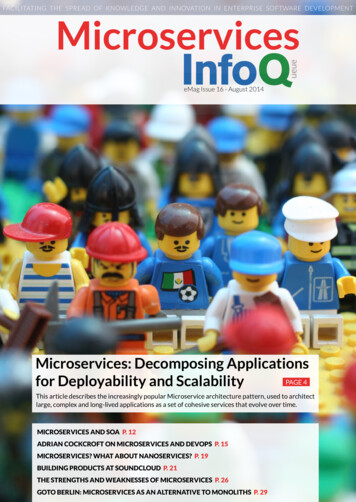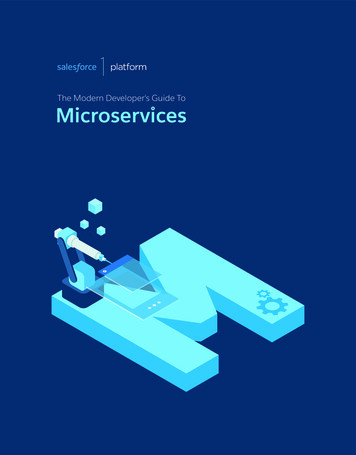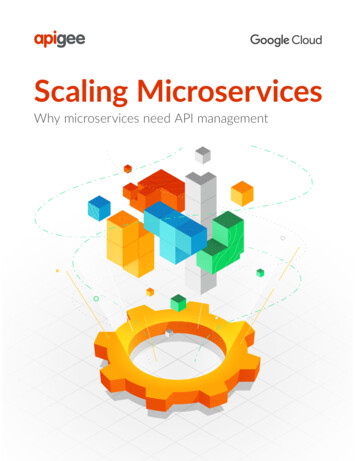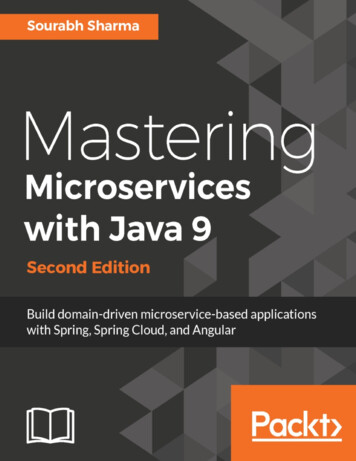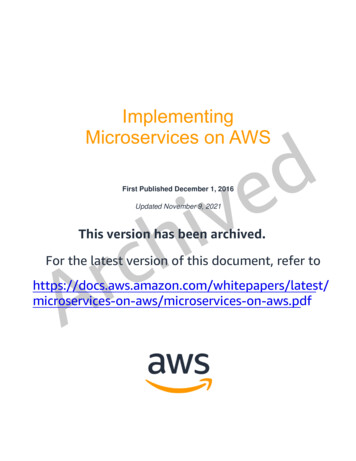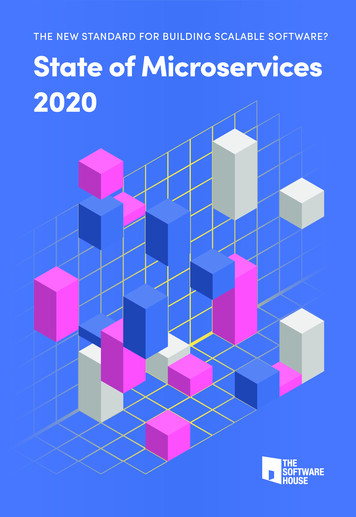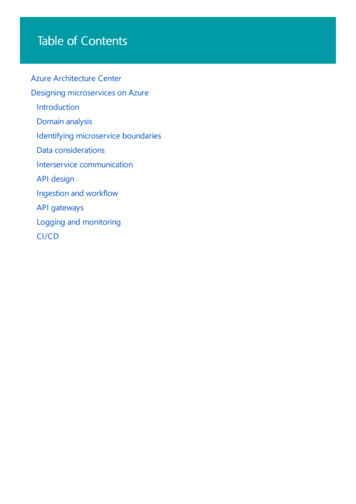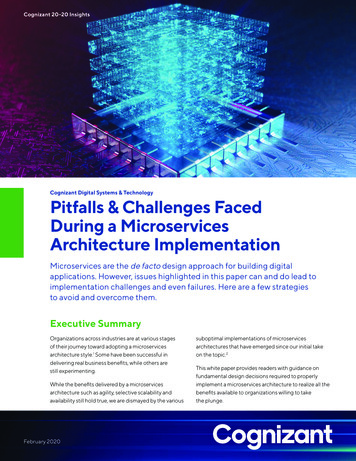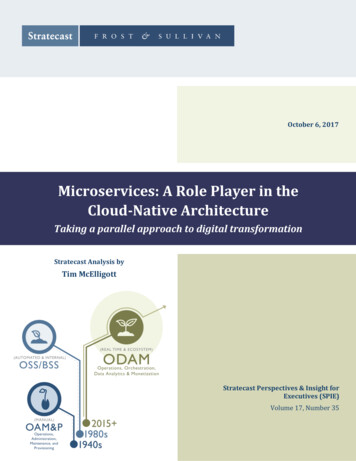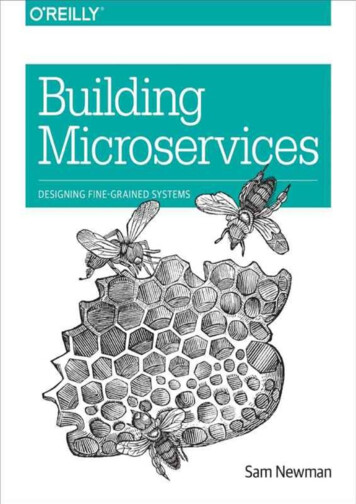
Transcription
Building MicroservicesSam Newman
Building Microservicesby Sam NewmanCopyright 2015 Sam Newman. All rights reserved.Printed in the United States of America.Published by O’Reilly Media, Inc., 1005 Gravenstein Highway North, Sebastopol, CA95472.O’Reilly books may be purchased for educational, business, or sales promotional use.Online editions are also available for most titles (http://safaribooksonline.com). For moreinformation, contact our corporate/institutional sales department: 800-998-9938 orcorporate@oreilly.com.Editors: Mike Loukides and Brian MacDonaldProduction Editor: Kristen BrownCopyeditor: Rachel MonaghanProofreader: Jasmine KwitynIndexer: Judith McConvilleInterior Designer: David FutatoCover Designer: Ellie VolckhausenIllustrator: Rebecca DemarestFebruary 2015: First Edition
Revision History for the First Edition2014-01-30: First ReleaseSee http://oreilly.com/catalog/errata.csp?isbn 9781491950357 for release details.The O’Reilly logo is a registered trademark of O’Reilly Media, Inc. BuildingMicroservices, the cover image of honey bees, and related trade dress are trademarks ofO’Reilly Media, Inc.While the publisher and the author have used good faith efforts to ensure that theinformation and instructions contained in this work are accurate, the publisher and theauthor disclaim all responsibility for errors or omissions, including without limitationresponsibility for damages resulting from the use of or reliance on this work. Use of theinformation and instructions contained in this work is at your own risk. If any codesamples or other technology this work contains or describes is subject to open sourcelicenses or the intellectual property rights of others, it is your responsibility to ensure thatyour use thereof complies with such licenses and/or rights.978-1-491-95035-7[LSI]
PrefaceMicroservices are an approach to distributed systems that promote the use of finelygrained services with their own lifecycles, which collaborate together. Becausemicroservices are primarily modeled around business domains, they avoid the problems oftraditional tiered architectures. Microservices also integrate new technologies andtechniques that have emerged over the last decade, which helps them avoid the pitfalls ofmany service-oriented architecture implementations.This book is full of concrete examples of microservice use around the world, including inorganizations like Netflix, Amazon, Gilt, and the REA group, who have all found that theincreased autonomy this architecture gives their teams is a huge advantage.
Who Should Read This BookThe scope of this book is broad, as the implications of fine-grained microservicearchitectures are also broad. As such, it should appeal to people interested in aspects ofdesign, development, deployment, testing, and maintenance of systems. Those of you whohave already embarked on the journey toward finer-grained architectures, whether for agreenfield application or as part of decomposing an existing, more monolithic system, willfind plenty of practical advice to help you. It will also help those of you who want to knowwhat all the fuss is about, so that you can determine whether microservices are right foryou.
Why I Wrote This BookI started thinking about the topic of application architectures many years ago, whenworking to help people deliver their software faster. I realized that while infrastructureautomation, testing, and continuous delivery techniques could help, if the fundamentaldesign of the system doesn’t make it easy to make changes, then there are limits to whatcan be accomplished.At the same time, many organizations were experimenting with finer-grained architecturesto accomplish similar goals, but also to achieve things like improved scaling, increasingautonomy of teams, or to more easily embrace new technologies. My own experiences, aswell as those of my colleagues at ThoughtWorks and elsewhere, reinforced the fact thatusing larger numbers of services with their own independent lifecycles resulted in moreheadaches that had to be dealt with. In many ways, this book was imagined as a one-stopshop that would help encompass the wide variety of topics that are necessary forunderstanding microservices — something that would have helped me greatly in the past!
A Word on Microservices TodayMicroservices is a fast-moving topic. Although the idea is not new (even if the term itselfis), experiences from people all over the world, along with the emergence of newtechnologies, are having a profound effect on how they are used. Due to the fast pace ofchange, I have tried to focus this book on ideas more than specific technologies, knowingthat implementation details always change faster than the thoughts behind them.Nonetheless, I fully expect that in a few years from now we’ll have learned even moreabout where microservices fit, and how to use them well.So while I have done my best to distill out the essence of the topic in this book, if thistopic interests you, be prepared for many years of continuous learning to keep on top ofthe state of the art!
Navigating This BookThis book is primarily organized in a topic-based format. As such, you may want to jumpinto the specific topics that interest you the most. While I have done my best to referenceterms and ideas in the earlier chapters, I’d like to think that even people who considerthemselves fairly experienced will find something of interest in all chapters here. I wouldcertainly suggest that you take a look at Chapter 2, which touches on the breadth of thetopic as well as providing some framing for how I go about things in case if you want todive deeper into some of the later topics.For people new to the subject, I’ve structured the chapters in a way that I hope will makesense to read from beginning to end.Here is an overview of what we cover:Chapter 1, MicroservicesWe’ll begin with an introduction to microservices, including the key benefits as wellas some of the downsides.Chapter 2, The Evolutionary ArchitectThis chapter discusses the difficulties we face in terms of making trade-offs asarchitects, and covers specifically just how many things we need to think about withmicroservices.Chapter 3, How to Model ServicesHere we’ll start to define the boundary of microservices, using techniques fromdomain-driven design to help focus our thinking.Chapter 4, IntegrationThis is where we start getting a bit deeper into specific technology implications, aswe discuss what sorts of service collaboration techniques will help us most. We’llalso delve into the topic of user interfaces and integrating with legacy andcommercial off-the-shelf (COTS) products.Chapter 5, Splitting the MonolithMany people get interested in microservices as an antidote to large, hard-to-changemonolithic systems, and this is exactly what we’ll cover in detail in this chapter.Chapter 6, DeploymentAlthough this book is primarily theoretical, few topics in the book have been asimpacted by recent changes in technology as deployment, which we’ll explore here.Chapter 7, Testing
This chapter goes deep into the topic of testing, an area of particular concern whenhandling the deployment of multiple discrete services. Of particular note will be therole that consumer-driven contracts can play in helping us ensure the quality of oursoftware.Chapter 8, MonitoringTesting our software before production doesn’t help if problems occur once we golive, and this chapter explores how we can monitor our fine-grained systems and dealwith some of the emergent complexity of distributed systems.Chapter 9, SecurityHere we’ll examine the security aspects of microservices and consider how to handleuser-to-service and service-to-service authentication and authorization. Security is avery important topic in computing, one that is all too readily ignored. Although I amin no way a security expert, I hope that this chapter will at least help you considersome of the aspects you need to be aware of when building systems, andmicroservice systems in particular.Chapter 10, Conway’s Law and System DesignThis chapter focuses on the interplay of organizational structure and architecture.Many organizations have realized that trouble will occur if you don’t keep the two inharmony. We’ll attempt to get to the bottom of this dilemma, and consider somedifferent ways to align system design with the structure of your teams.Chapter 11, Microservices at ScaleThis is where we start looking at doing all of this at scale, so that we can handle theincreased chance of failure that can happen with large numbers of services, as well aslarge volumes of traffic.Chapter 12, Bringing It All TogetherThe final chapter attempts to distill down the core essence of what makesmicroservices different. It includes a list of seven microservices principles, as well asa wrap-up of the key points of the book.
Conventions Used in This BookThe following typographical conventions are used in this book:ItalicIndicates new terms, URLs, email addresses, filenames, and file extensions.Constant widthUsed for program listings, as well as within paragraphs to refer to program elementssuch as variable or function names, databases, data types, environment variables,statements, and keywords.Constant width boldShows commands or other text that should be typed literally by the user.Constant width italicShows text that should be replaced with user-supplied values or by values determinedby context.
Safari Books OnlineNOTESafari Books Online is an on-demand digital library that delivers expert content in bothbook and video form from the world’s leading authors in technology and business.Technology professionals, software developers, web designers, and business and creativeprofessionals use Safari Books Online as their primary resource for research, problemsolving, learning, and certification training.Safari Books Online offers a range of plans and pricing for enterprise, government,education, and individuals.Members have access to thousands of books, training videos, and prepublicationmanuscripts in one fully searchable database from publishers like O’Reilly Media,Prentice Hall Professional, Addison-Wesley Professional, Microsoft Press, Sams, Que,Peachpit Press, Focal Press, Cisco Press, John Wiley & Sons, Syngress, MorganKaufmann, IBM Redbooks, Packt, Adobe Press, FT Press, Apress, Manning, New Riders,McGraw-Hill, Jones & Bartlett, Course Technology, and hundreds more. For moreinformation about Safari Books Online, please visit us online.
How to Contact UsPlease address comments and questions concerning this book to the publisher:O’Reilly Media, Inc.1005 Gravenstein Highway NorthSebastopol, CA 95472800-998-9938 (in the United States or Canada)707-829-0515 (international or local)707-829-0104 (fax)We have a web page for this book, where we list errata, examples, and any additionalinformation. You can access this page at http://bit.ly/building-microservices.To comment or ask technical questions about this book, send email tobookquestions@oreilly.com.For more information about our books, courses, conferences, and news, see our website athttp://www.oreilly.com.Find us on Facebook: http://facebook.com/oreillyFollow us on Twitter: http://twitter.com/oreillymediaWatch us on YouTube: http://www.youtube.com/oreillymedia
AcknowledgmentsThis book is dedicated to Lindy Stephens, without whom it wouldn’t exist. Sheencouraged me to start on this journey, supported me throughout the often stressfulprocess of writing, and is the best partner I could have ever asked for. I would also like todedicate this to my dad, Howard Newman, who has always been there for me. This is forboth of you.I would like to single out Ben Christensen, Vivek Subramaniam, and Martin Fowler forproviding detailed feedback throughout the writing process, helping shape what this bookbecame. I’d also like to thank James Lewis, with whom I have consumed many beersdiscussing the ideas presented in this book. This book would be a shadow of itself withouttheir help and guidance.In addition, many others provided help and feedback on early versions of the book.Specifically, I would like to thank (in no particular order) Kane Venables, AnandKrishnaswamy, Kent McNeil, Charles Haynes, Chris Ford, Aidy Lewis, Will Thames, JonEaves, Rolf Russell, Badrinath Janakiraman, Daniel Bryant, Ian Robinson, Jim Webber,Stewart Gleadow, Evan Bottcher, Eric Sword, Olivia Leonard, and all my other colleaguesat ThoughtWorks and across the industry who have helped me get this far.Finally, I would like to thank all the people at O’Reilly, including Mike Loukides forgetting me on board, my editor Brian MacDonald, Rachel Monaghan, Kristen Brown,Betsy Waliszewski, and all the other people who have helped in ways I may never knowabout.
Chapter 1. MicroservicesFor many years now, we have been finding better ways to build systems. We have beenlearning from what has come before, adopting new technologies, and observing how anew wave of technology companies operate in different ways to create IT systems thathelp make both their customers and their own developers happier.Eric Evans’s book Domain-Driven Design (Addison-Wesley) helped us understand theimportance of representing the real world in our code, and showed us better ways to modelour systems. The concept of continuous delivery showed how we can more effectively andefficiently get our software into production, instilling in us the idea that we should treatevery check-in as a release candidate. Our understanding of how the Web works has led usto develop better ways of having machines talk to other machines. Alistair Cockburn’sconcept of hexagonal architecture guided us away from layered architectures wherebusiness logic could hide. Virtualization platforms allowed us to provision and resize ourmachines at will, with infrastructure automation giving us a way to handle these machinesat scale. Some large, successful organizations like Amazon and Google espoused the viewof small teams owning the full lifecycle of their services. And, more recently, Netflix hasshared with us ways of building antifragile systems at a scale that would have been hard tocomprehend just 10 years ago.Domain-driven design. Continuous delivery. On-demand virtualization. Infrastructureautomation. Small autonomous teams. Systems at scale. Microservices have emerged fromthis world. They weren’t invented or described before the fact; they emerged as a trend, ora pattern, from real-world use. But they exist only because of all that has gone before.Throughout this book, I will pull strands out of this prior work to help paint a picture ofhow to build, manage, and evolve microservices.Many organizations have found that by embracing fine-grained, microservicearchitectures, they can deliver software faster and embrace newer technologies.Microservices give us significantly more freedom to react and make different decisions,allowing us to respond faster to the inevitable change that impacts all of us.
What Are Microservices?Microservices are small, autonomous services that work together. Let’s break thatdefinition down a bit and consider the characteristics that make microservices different.
Small, and Focused on Doing One Thing WellCodebases grow as we write code to add new features. Over time, it can be difficult toknow where a change needs to be made because the codebase is so large. Despite a drivefor clear, modular monolithic codebases, all too often these arbitrary in-processboundaries break down. Code related to similar functions starts to become spread all over,making fixing bugs or implementations more difficult.Within a monolithic system, we fight against these forces by trying to ensure our code ismore cohesive, often by creating abstractions or modules. Cohesion — the drive to haverelated code grouped together — is an important concept when we think aboutmicroservices. This is reinforced by Robert C. Martin’s definition of the SingleResponsibility Principle, which states “Gather together those things that change for thesame reason, and separate those things that change for different reasons.”Microservices take this same approach to independent services. We focus our serviceboundaries on business boundaries, making it obvious where code lives for a given pieceof functionality. And by keeping this service focused on an explicit boundary, we avoidthe temptation for it to grow too large, with all the associated difficulties that this canintroduce.The question I am often asked is how small is small? Giving a number for lines of code isproblematic, as some languages are more expressive than others and can therefore domore in fewer lines of code. We must also consider the fact that we could be pulling inmultiple dependencies, which themselves contain many lines of code. In addition, somepart of your domain may be legitimately complex, requiring more code. Jon Eaves atRealEstate.com.au in Australia characterizes a microservice as something that could berewritten in two weeks, a rule of thumb that makes sense for his particular context.Another somewhat trite answer I can give is small enough and no smaller. When speakingat conferences, I nearly always ask the question who has a system that is too big and thatyou’d like to break down? Nearly everyone raises their hands. We seem to have a verygood sense of what is too big, and so it could be argued that once a piece of code nolonger feels too big, it’s probably small enough.A strong factor in helping us answer how small? is how well the service aligns to teamstructures. If the codebase is too big to be managed by a small team, looking to break itdown is very sensible. We’ll talk more about organizational alignment later on.When it comes to how small is small enough, I like to think in these terms: the smaller theservice, the more you maximize the benefits and downsides of microservice architecture.As you get smaller, the benefits around interdependence increase. But so too does some ofthe complexity that emerges from having more and more moving parts, something that wewill explore throughout this book. As you get better at handling this complexity, you canstrive for smaller and smaller services.
AutonomousOur microservice is a separate entity. It might be deployed as an isolated service on aplatform as a service (PAAS), or it might be its own operating system process. We try toavoid packing multiple services onto the same machine, although the definition ofmachine in today’s world is pretty hazy! As we’ll discuss later, although this isolation canadd some overhead, the resulting simplicity makes our distributed system much easier toreason about, and newer technologies are able to mitigate many of the challengesassociated with this form of deployment.All communication between the services themselves are via network calls, to enforceseparation between the services and avoid the perils of tight coupling.These services need to be able to change independently of each other, and be deployed bythemselves without requiring consumers to change. We need to think about what ourservices should expose, and what they should allow to be hidden. If there is too muchsharing, our consuming services become coupled to our internal representations. Thisdecreases our autonomy, as it requires additional coordination with consumers whenmaking changes.Our service exposes an application programming interface (API), and collaboratingservices communicate with us via those APIs. We also need to think about whattechnology is appropriate to ensure that this itself doesn’t couple consumers. This maymean picking technology-agnostic APIs to ensure that we don’t constrain technologychoices. We’ll come back time and again to the importance of good, decoupled APIsthroughout this book.Without decoupling, everything breaks down for us. The golden rule: can you make achange to a service and deploy it by itself without changing anything else? If the answer isno, then many of the advantages we discuss throughout this book will be hard for you toachieve.To do decoupling well, you’ll need to model your services right and get the APIs right. I’llbe talking about that a lot.
Key BenefitsThe benefits of microservices are many and varied. Many of these benefits can be laid atthe door of any distributed system. Microservices, however, tend to achieve these benefitsto a greater degree primarily due to how far they take the concepts behind distributedsystems and service-oriented architecture.
Technology HeterogeneityWith a system composed of multiple, collaborating services, we can decide to use differenttechnologies inside each one. This allows us to pick the right tool for each job, rather thanhaving to select a more standardized, one-size-fits-all approach that often ends up beingthe lowest common denominator.If one part of our system needs to improve its performance, we might decide to use adifferent technology stack that is better able to achieve the performance levels required.We may also decide that how we store our data needs to change for different parts of oursystem. For example, for a social network, we might store our users’ interactions in agraph-oriented database to reflect the highly interconnected nature of a social graph, butperhaps the posts the users make could be stored in a document-oriented data store, givingrise to a heterogeneous architecture like the one shown in Figure 1-1.Figure 1-1. Microservices can allow you to more easily embrace different technologiesWith microservices, we are also able to adopt technology more quickly, and understandhow new advancements may help us. One of the biggest barriers to trying out andadopting new technology is the risks associated with it. With a monolithic application, if Iwant to try a new programming language, database, or framework, any change will impacta large amount of my system. With a system consisting of multiple services, I havemultiple new places in which to try out a new piece of technology. I can pick a service thatis perhaps lowest risk and use the technology there, knowing that I can limit any potentialnegative impact. Many organizations find this ability to more quickly absorb newtechnologies to be a real advantage for them.Embracing multiple technologies doesn’t come without an overhead, of course. Someorganizations choose to place some constraints on language choices. Netflix and Twitter,for example, mostly use the Java Virtual Machine (JVM) as a platform, as they have avery good understanding of the reliability and performance of that system. They alsodevelop libraries and tooling for the JVM that make operating at scale much easier, butmake it more difficult for non-Java-based services or clients. But neither Twitter norNetflix use only one technology stack for all jobs, either. Another counterpoint to concerns
about mixing in different technologies is the size. If I really can rewrite my microservicein two weeks, you may well mitigate the risks of embracing new technology.As you’ll find throughout this book, just like many things concerning microservices, it’sall about finding the right balance. We’ll discuss how to make technology choices inChapter 2, which focuses on evolutionary architecture; and in Chapter 4, which deals withintegration, you’ll learn how to ensure that your services can evolve their technologyindependently of each other without undue coupling.
ResilienceA key concept in resilience engineering is the bulkhead. If one component of a systemfails, but that failure doesn’t cascade, you can isolate the problem and the rest of thesystem can carry on working. Service boundaries become your obvious bulkheads. In amonolithic service, if the service fails, everything stops working. With a monolithicsystem, we can run on multiple machines to reduce our chance of failure, but withmicroservices, we can build systems that handle the total failure of services and degradefunctionality accordingly.We do need to be careful, however. To ensure our microservice systems can properlyembrace this improved resilience, we need to understand the new sources of failure thatdistributed systems have to deal with. Networks can and will fail, as will machines. Weneed to know how to handle this, and what impact (if any) it should have on the end userof our software.We’ll talk more about better handling resilience, and how to handle failure modes, inChapter 11.
ScalingWith a large, monolithic service, we have to scale everything together. One small part ofour overall system is constrained in performance, but if that behavior is locked up in agiant monolithic application, we have to handle scaling everything as a piece. Withsmaller services, we can just scale those services that need scaling, allowing us to runother parts of the system on smaller, less powerful hardware, like in Figure 1-2.Figure 1-2. You can target scaling at just those microservices that need itGilt, an online fashion retailer, adopted microservices for this exact reason. Starting in2007 with a monolithic Rails application, by 2009 Gilt’s system was unable to cope withthe load being placed on it. By splitting out core parts of its system, Gilt was better able todeal with its traffic spikes, and today has over 450 microservices, each one running onmultiple separate machines.When embracing on-demand provisioning systems like those provided by Amazon WebServices, we can even apply this scaling on demand for those pieces that need it. Thisallows us to control our costs more effectively. It’s not often that an architectural approachcan be so closely correlated to an almost immediate cost savings.
Ease of DeploymentA one-line change to a million-line-long monolithic application requires the wholeapplication to be deployed in order to release the change. That could be a large-impact,high-risk deployment. In practice, large-impact, high-risk deployments end up happeninginfrequently due to understandable fear. Unfortunately, this means that our changes buildup and build up between releases, until the new version of our application hittingproduction has masses of changes. And the bigger the delta between releases, the higherthe risk that we’ll get something wrong!With microservices, we can make a change to a single service and deploy it independentlyof the rest of the system. This allows us to get our code deployed faster. If a problem doesoccur, it can be isolated quickly to an individual service, making fast rollback easy toachieve. It also means we can get our new functionality out to customers faster. This isone of the main reasons why organizations like Amazon and Netflix use thesearchitectures — to ensure they remove as many impediments as possible to gettingsoftware out the door.The technology in this space has changed greatly in the last couple of years, and we’ll belooking more deeply into the topic of deployment in a microservice world in Chapter 6.
Organizational AlignmentMany of us have experienced the problems associated with large teams and largecodebases. These problems can be exacerbated when the team is distributed. We alsoknow that smaller teams working on smaller codebases tend to be more productive.Microservices allow us to better align our architecture to our organization, helping usminimize the number of people working on any one codebase to hit the sweet spot of teamsize and productivity. We can also shift ownership of services between teams to try to keeppeople working on one service colocated. We will go into much more detail on this topicwhen we discuss Conway’s law in Chapter 10.
ComposabilityOne of the key promises of distributed systems and service-oriented architectures is thatwe open up opportunities for reuse of functionality. With microservices, we allow for ourfunctionality to be consumed in different ways for different purposes. This can beespecially important when we think about how our consumers use our software. Gone isthe time when we could think narrowly about either our desktop website or mobileapplication. Now we need to think of the myriad ways that we might want to weavetogether capabilities for the Web, native application, mobile web, tablet app, or wearabledevice. As organizations move away from thinking in terms of narrow channels to moreholistic concepts of customer engagement, we need architectures that can keep up.With microservices, think of us opening up seams in our system that are addressable byoutside parties. As circumstances change, we can build things in different ways. With amonolithic application, I often have one coarse-grained seam that can be used from theoutside. If I want to break that up to get something more useful, I’ll need a hammer! InChapter 5, I’ll discuss ways for you to break apart existing monolithic systems, andhopefully change them into some reusable, re-composable microservices.
Optimizing for ReplaceabilityIf you work at a medium-size or bigger organization, chances are you are aware of somebig, nasty legacy system sitting in the corner. The one no one wants to touch. The one thatis vital to how your company runs, but that happens to be written in some odd Fortranvariant and runs only on hardware that reached end of life 25 years ago. Why hasn’t itbeen replaced? You know why: it’s too big and risky a job.With our individual services being small in size, the cost to replace them with a betterimplementation, or even delete them altogether, is much easier to manage. How often haveyou deleted more than a hundred lines of code in a single day and not worried too muchabout it? With microservices often being of similar size, the barriers to rewriting orremoving services entirely are very low.Teams using microservice approaches are comfortable with completely rewriting serviceswhen required, and just killing a service when it is no longer needed. When a codebase isjust a few hundred lines long, it is difficult f
Microservices are an approach to distributed systems that promote the use of finely grained services with their own lifecycles, which collaborate together. Because microservices are primarily modeled around business domains, they avoid the problems of traditional tiered architectures. Microservices also integrate new technologies and
